PArK - Probabilistic Assessment of Climate Change for Decades in the Near Future
- Contact: Dr. Hans-Jürgen Panitz, Dr. G. Schädler
- Project Group:
IMK-TRO
- Funding:
State of Baden-Württemberg
PArK is a project within the research program „Herausforderung Klimawandel“ financed by the Federal Government of Baden-Württemberg. Aim of the program is to asses the impacts and risks of climate change for the area of Baden-Württemberg. The sub-project aims at the probabilistic assessment of climate change for decades in the near future. Results of ensemble simulations will be analysed with Bayesian statistics in order to quantify the most likely climate development, including its uncertainties.
Sub-project: Regional Dynamical Simulations with CCLM
Aims
The project PArK aims at the probabilistic assessment of changes in mean values of temperature and precipitation during the decades from 2011 to 2040 for the area of Baden-Württemberg. Results based on complementary methods (probabilistic-dynamical and statistical downscaling techniques) and data sources (regional climate models driven by different realisations of global model simulations) are produced and analysed with Bayesian statistics in order to quantify the most likely climate development, including its uncertainties. The quantification of uncertainties, again based on ensemble statistics, is an essential aspect of this project.
Project partners
The project is carried out in close cooperation with the Prof. Hense, Meteorological Institute, University of Bonn, and Climate & Environment Consulting (CEC), Potsdam. CEC contributed to the PArK project by the application of the statistical downscaling model WETTREG. The colleagues in Bonn gather the results of the climate models and perform their statistical evaluation.
Methodology
To reach the goal of the project it is necessary to create multi-model, multi-member ensembles of climate simulations. Driving data from global climate simulations with ECHAM5 and other global models like Had3CM and CGCM3 in various realisations are used to initialise and drive the regional climate model COSMO-CLM (CCLM) which is the climate version of the operational weather forecast model COSMO of the German Weather Service (DWD). The global ERA40 reanalyses have been used to evaluate the model. In order to assess the impact of climate change in small scale regions like Baden-Württemberg it is necessary to perform model simulations with a high spatial resolution less than 10 km. To avoid a too large step in the grid sizes from the global to the regional model, a double nesting technique is used for the dynamical downscaling. In a first step the large scale data are used to drive a CCLM simulation with a horizontal grid size of 0.44 deg (about 50 km in our latitudes). The chosen model domain for this first nest (Fig.1) includes most parts of Europe and parts of Asia and northern Africa. In the second step the results of this 50 km simulation are used to drive the CCLM simulations with grid spacing of 0.0625 deg (about 7 km). The corresponding model domain (Fig. 2) comprises Germany, northern Italy, the Benelux and parts of France. All simulations are carried out for the last three decades of the 20th century (20C, 1968 – 2000, first three years serve as spin-up) and for the years from 2007 until 2040, assuming the A1B SRES scenario. Simulations carried out based on ERA40 and ECHAM5 global data sets and due to the double nesting strategy, ten CCLM simulations (Table 1) have been carried out up to now using the high performance computing facilities at the High Performance Computing Centre Stuttgart (HLRS).
Results
Air Temperature at 2 m height
The air temperature at 2 m height (T_2M) calculated in the evaluation run (run no.1) has been compared with the ECAD (ECAD: European Climate Assessment and Data; Haylock et al., 2008) gridded data set; this daily data set based on observations matches exactly the 50 km-grid of the CCLM simulations. Discarding a model spin-up time of three years, the comparison has been performed for the period from 1971 until 2001. For the comparison the data are temporally averaged over each month and also spatially over all land-points of the model domain (Fig. 1). On the average the simulation result (Fig. 3) shows a cold bias of about 1K. However, the trend of the temperature anomaly is nearly identical for simulation and observation. The anomaly plot (Fig. 4) suggests that at the present stage, simulation of changes may be more reliable than simulation of absolute values.
Precipitation
The ECAD gridded data set also contains daily precipitation data. In contrast to the temperature, precipitation (Fig. 5) is overestimated by the model. On the average the model precipitation is about 11 mm too high. This overestimation seems to be caused by a complex interplay of model numeric and model physics and it depends also on the region considered. The causes of the overestimation are currently analysed.
Figures and Tables
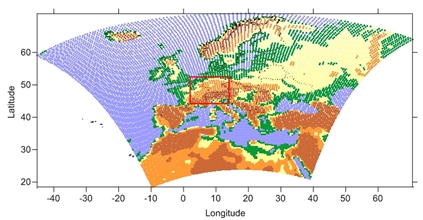
Setup of CCLM Simulation Nest 1 NX = 118, NY =110, NZ = 40 ?X = ?Y = 0.44° ˜ 50 km Time Interval of Simulation: C20: 1968 – 2000, three years of spin-up A1B: 2007 – 2040, three year of spin-up
Figure 1: Model domain of first nest (50 km) and the corresponding model setup. The strange shape results from the rotated coordinate system of the model. The red frame indicates the high resolution (7 km) domain shown below.
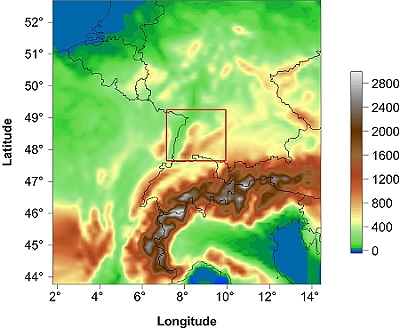
Setup of CCLM Simulation Nest 2 NX = 124, NY =140, NZ = 40 ?X = ?Y = 0.0625° ˜ 7 km Time Interval of Simulation: C20: 1968 – 2000, three years of spin-up A1B: 2007 – 2040, three year of spin-up
Figure 2: Illustration of model domain of second nest (7 km) and the corresponding model setup. The red box indicates the actual area of interest.
Table 1: Summary of CCLM simulations.
| Global Data | Period | Run No | Nesting | External- Forcing | Resolution (Deg) | Status |
| ERA40 | 1968-2001 | 1 2 |
Nest 1 Nest 2 |
ERA40 CLM_50km |
0.44 0.0625 |
finished finished |
| ECHAM5_20C3M full forcing, Realization 1 | 1968-2000 | 3 4 |
Nest 1 Nest 2 |
ECHAM5 CLM_50km |
0.44 0.0625 |
finished finished |
| ECHAM5_20C3M full forcing, Realization 3 | 1968-2000 | 5 6 |
Nest 1 Nest 2 |
ECHAM5 CLM_50km |
0.44 0.0625 |
finished finished |
| ECHAM5_A1B Realization 1 | 2007-2041 |
7 |
Nest 1 Nest 2 |
ECHAM5 CLM_50km |
0.44 0.0625 |
finished finished |
| ECHAM5_A1B Realization 3 | 2007-2041 | 9 10 |
Nest 1 Nest 2 |
ECHAM5 CLM_50km |
0.44 0.0625 |
finished finished |
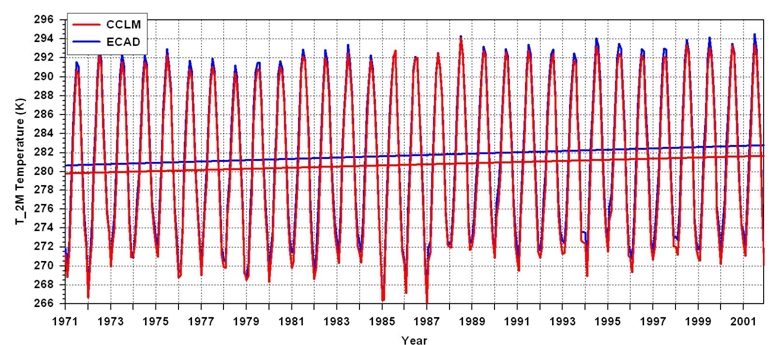
Figure 3: Monthly means of T_2M and 31-years temperature trend for the period 1971 until 2001. Shown are the results of CCLM evaluation run (red curves) and the ECAD observational data (blue curves).
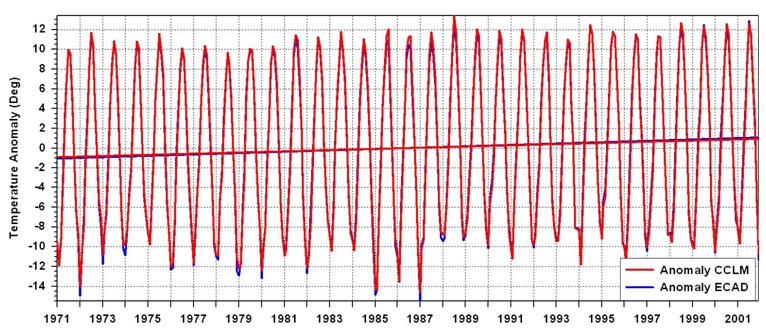
Figure 4: Anomaly (T-Tavg) of monthly T_2M data and its trend for the period 1971- 2001 Red curve: CCLM anomaly, Tavg = 280.72 K blue curve: ECAD anomaly, Tavg = 281.70 K
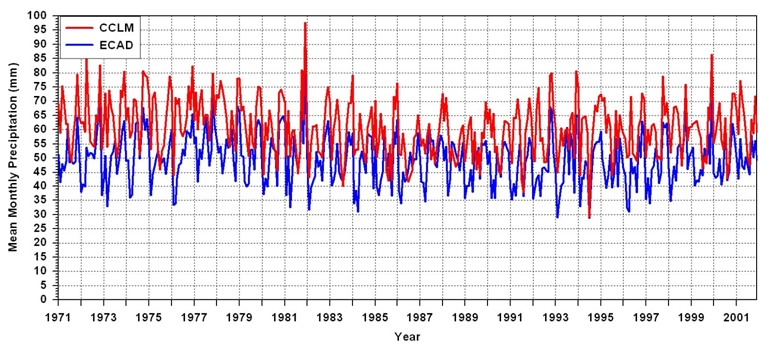
Figure 5: Mean monthly sum of total precipitation. The red curve shows the results of the CCLM evaluation run, the blue curve represents the ECAD observational data.
Outlook
The ensemble aspect is very important in climate modelling. The present ensemble is still too small for reliable statistical investigations. Therefore, it is intended to increase the number of ensemble members using different realizations of further GCM climate scenarios as forcing data. Simulations using data from the HadCM3 GCM of the British Hadley Centre for Climate Prediction and Research, Bracknell, Berks, UK are presently carried out.
Publications:
Panitz, H.-J., G. Schädler, H. Feldmann (2009): Modelling Regional Climate Change in Southwest Germany. To be published in: High Performance Computing in Science and Engineering ‚09: Transactions of the High Performance Computing Center Stuttgart (HLRS) 2009. Springer Verlag Berlin, Heidelberg
Cooperation:
Meteorological Institute, University Bonn, CLM-Community, German Weather Service (DWD), High Performance Computing Centre Stuttgart (HLRS)
